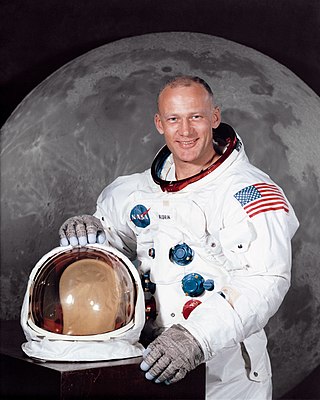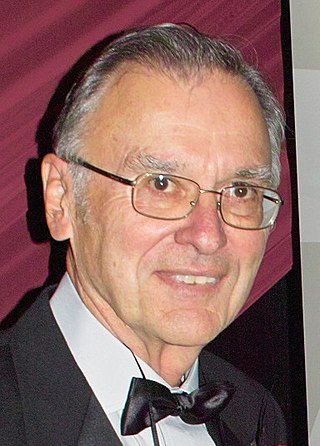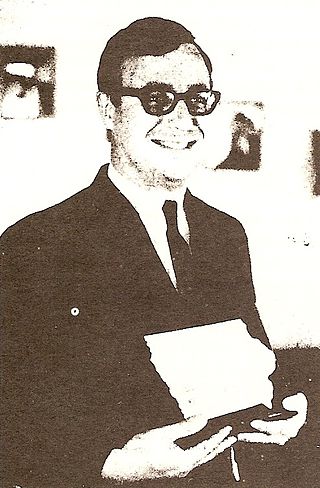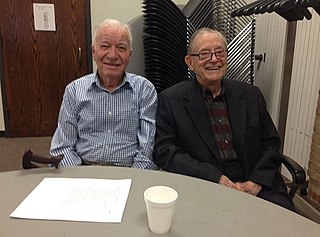
Buzz Aldrin is an American former astronaut, engineer and fighter pilot. He made three spacewalks as pilot of the 1966 Gemini 12 mission. He was the Lunar Module Eagle pilot on the 1969 Apollo 11 mission and became the second person to walk on the Moon after mission commander Neil Armstrong.

The Apollo Guidance Computer (AGC) was a digital computer produced for the Apollo program that was installed on board each Apollo command module (CM) and Apollo Lunar Module (LM). The AGC provided computation and electronic interfaces for guidance, navigation, and control of the spacecraft. The AGC was the first computer based on silicon integrated circuits. The computer's performance was comparable to the first generation of home computers from the late 1970s, such as the Apple II, TRS-80, and Commodore PET.

In Boolean logic, logical NOR or non-disjunction or joint denial is a truth-functional operator which produces a result that is the negation of logical or. That is, a sentence of the form (p NOR q) is true precisely when neither p nor q is true—i.e. when both of p and q are false. It is logically equivalent to and , where the symbol signifies logical negation, signifies OR, and signifies AND.

Edgar Dean Mitchell was a United States Navy officer and aviator, test pilot, aeronautical engineer, ufologist, and NASA astronaut. As the Lunar Module Pilot of Apollo 14 in 1971 he spent nine hours working on the lunar surface in the Fra Mauro Highlands region, and was the sixth person to walk on the Moon.

Marcian Edward "Ted" Hoff Jr. is one of the inventors of the microprocessor.

Robert Elliot Kahn is an American electrical engineer who, along with Vint Cerf, first proposed the Transmission Control Protocol (TCP) and the Internet Protocol (IP), the fundamental communication protocols at the heart of the Internet.

Fred Wallace Haise Jr. is an American former NASA astronaut, engineer, fighter pilot with the U.S. Marine Corps and U.S. Air Force, and a test pilot. He is one of 24 people to have flown to the Moon, having flown as Lunar Module Pilot on Apollo 13. He was slated to become the 6th person to walk on the Moon, but the Apollo 13 landing mission was aborted en route.
Draper Laboratory is an American non-profit research and development organization, headquartered in Cambridge, Massachusetts; its official name is The Charles Stark Draper Laboratory, Inc. The laboratory specializes in the design, development, and deployment of advanced technology solutions to problems in national security, space exploration, health care and energy.

Charles Stark "Doc" Draper was an American scientist and engineer, known as the "father of inertial navigation". He was the founder and director of the Massachusetts Institute of Technology's Instrumentation Laboratory, later renamed the Charles Stark Draper Laboratory, which made the Apollo Moon landings possible through the Apollo Guidance Computer it designed for NASA.

Core rope memory is a form of read-only memory (ROM) for computers, first used in the 1960s by early NASA Mars space probes and then in the Apollo Guidance Computer (AGC) and programmed by the Massachusetts Institute of Technology (MIT) Instrumentation Lab and built by Raytheon.

George Robert Stibitz was a Bell Labs researcher internationally recognized as one of the fathers of the modern digital computer. He was known for his work in the 1930s and 1940s on the realization of Boolean logic digital circuits using electromechanical relays as the switching element.

The Apollo primary guidance, navigation, and control system was a self-contained inertial guidance system that allowed Apollo spacecraft to carry out their missions when communications with Earth were interrupted, either as expected, when the spacecraft were behind the Moon, or in case of a communications failure. The Apollo command module (CM) and lunar module (LM), were each equipped with a version of PGNCS. PGNCS, and specifically its computer, were also the command center for all system inputs from the LM, including the alignment optical telescope, the radar system, the manual translation and rotation device inputs by the astronauts as well as other inputs from the LM systems.

The American Computer & Robotics Museum (ACRM), formerly known as the American Computer Museum, is a museum of the history of computing, communications, artificial intelligence and robotics that is located in Bozeman, Montana, United States.

Steve Bales is a former NASA engineer and flight controller. He is best known for his role during the Apollo 11 lunar landing.

John Royer "Jack" Garman was a computer engineer, former senior NASA executive and noted key figure of the Apollo 11 lunar landing. As a young specialist on duty during the final descent stage on 20 July 1969 he dealt with a series of computer alarms which could have caused the mission to be aborted.
Albert L. Hopkins Jr. was an American computer designer. He worked at the US MIT Instrumentation Laboratory during the development of the Apollo Guidance, Navigation, and Control System, or the GN&C. The system was designed in two forms, one for the command module and one for the lunar module. The CM version included an optical system with an integrated scanning telescope and sextant for erecting and correcting the inertial platform. Albert Hopkins received a Ph.D. from Harvard University under Howard Aiken, he then joined the MIT Instrumentation Lab where he was Assistant Director; together with Ramon Alonso, and Hugh Blair-Smith he was a member of the group that designed the computer, designated AGC for Apollo Guidance Computer, identical in the CM and LM.

J. Halcombe "Hal" Laning Jr. was a Massachusetts Institute of Technology computer pioneer who in 1952 invented an algebraic compiler called George that ran on the MIT Whirlwind, the first real-time computer. Laning designed George to be an easier-to-use alternative to assembly language for entering mathematical equations into a computer. He later became a key contributor to the 1960s race to the Moon, with pioneering work on space-based guidance systems for the Apollo Moon missions. From 1955 to 1980, he was deputy associate director of the MIT Instrumentation Laboratory.
The Datamatic Division of Honeywell announced the H-800 electronic computer in 1958. The first installation occurred in 1960. A total of 89 were delivered. The H-800 design was part of a family of 48-bit word, three-address instruction format computers that descended from the Datamatic 1000, which was a joint Honeywell and Raytheon project started in 1955. The 1800 and 1800-II were follow-on designs to the H-800.

Margaret Elaine Hamilton is an American computer scientist, systems engineer, and business owner. She was director of the Software Engineering Division of the MIT Instrumentation Laboratory, which developed on-board flight software for NASA's Apollo program. She later founded two software companies—Higher Order Software in 1976 and Hamilton Technologies in 1986, both in Cambridge, Massachusetts.

Jerry Dale Merryman was an American electrical engineer and inventor. He was a member of the team at Texas Instruments that developed the first pocket calculator in 1965.

















